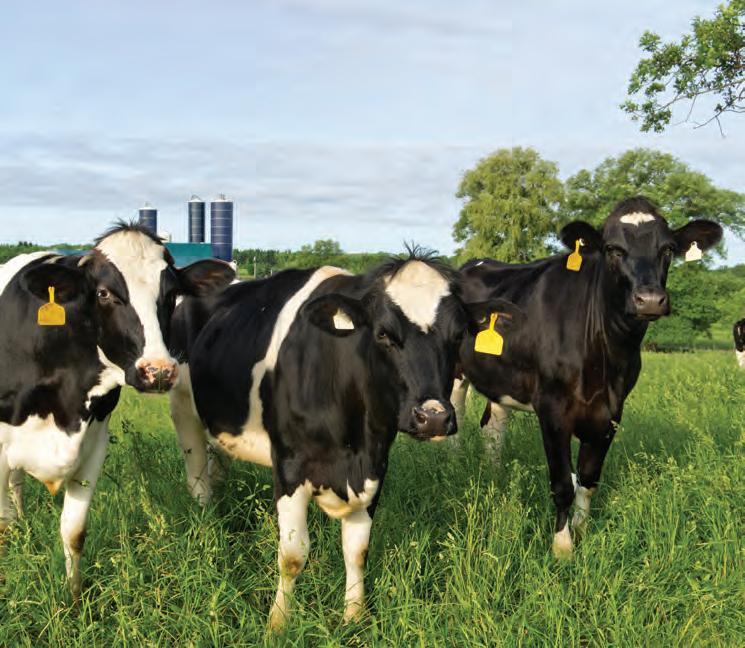
4 minute read
Research into practice
from Late Winter 2022
by MilkProducer
GETTING RESEARCH INTO PRACTICE
Making the jump from lab to on-farm implementation easier
By Lilian Schaer CONTRIBUTOR
There’s no shortage of research happening in the livestock industry in Canada and around the world, particularly related to dairy. Some discoveries end up being implemented by farmers and others in the sector, such as processors or veterinarians. A lot of research—and some would argue the majority— never actually make the jump to on-farm implementation.
How to improve that conversion rate and spur more adoption of research outcomes is an issue the industry has been grappling with. Now, efforts are underway to improve not just how research results get to producers, but also how to encourage change.
“In order for the Ontario livestock sector to be competitive and sustainable, farmers need a system that makes research results accessible in a way that encourages them to make effective decisions for their businesses,” says Mike McMorris, chief executive officer of Livestock Research Innovation Corporation (LRIC).
LRIC has been working with professor Ataharul Chowdhury from the University of Guelph’s school of environmental design and rural development to get a better handle on the issue and find ways to improve advisory services for Ontario’s livestock sector.
Since the Ontario Ministry of Agriculture, Food and Rural Affairs dramatically reduced its involvement with extension starting, the responsibility to get research results to farmers shifted to researchers, industry organizations and farm advisers beginning in the 1990s. A similar transition has taken place across North America, creating a patchwork of regional, provincial and sector-focused efforts.
ESTABLISHING A UNIFIED APPROACH
Working with graduate students Ezekiel Martin and André Melrose, Chowdhury’s research has found livestock advisory services in Ontario lack co-ordination and a unified approach.
There are significant differences between what is available for supply-managed and nonsupply managed sectors, and fee-for-service and product-linked advice has become far more prominent in the Ontario industry.
Dr. Steven Roche of ACER Consulting presented an LRIC horizon series webinar earlier this year and co-authored a white paper on the issue. He says there are challenges with under-served areas of the province where farmers don’t have the same level of access to advisers, such as veterinarians, agronomists, nutritionists and geneticists.
“If the government is relying on advisers to educate and work closely with producers, there is a significant reliance on them to have the right information-seeking behaviour and deliver it consistently across the province,” Roche notes during his webinar.
It’s about more than just access to information, he added. To be successful in getting farmers to adopt new practices, those delivering the information have to understand their audience, make their message relevant

To be successful in getting farmers to adopt new practices, those delivering the information have to understand their audience, make their message relevant and tailor their approach to fit farmers’ needs. - Dr. Steven Roche
and tailor their approach to fit farmers’ needs.
Chowdhury’s research showed, for example, although various advisory methods and tools are used, including more digital services and online media, those that are most effective focus on one-on-one, interactive communication with farmers.
Roche suggests three factors the industry must think about for getting research into practice:
•Improve and enhance our capacity, including training, scholarships and investments; •Ensure better collaboration between industry, academia, government and non-profit sectors; •Provide more co-ordination through a centre or structure that could help guide activities and motivate change.
COLLABORATION AND CO-ORDINATION TO DRIVE RESULTS
Efforts are already underway to bring more coordination, collaboration and focus to advisory services. In 2019, Canada joined the United States and Mexico to form the North American Agricultural Advisory Network (NAAAN) to bring together its farm and rural development advisers.
This past summer, NAAAN launched a mapping study to get a better understanding of agricultural training, education and advisory services and needs across North America. Results are expected shortly.
To read LRIC’s Getting Research Into Practice white paper or watch the horizon series webinar with Dr. Steven Roche, visit https:// livestockresearch.ca/white_papers.
For more information on Dr. Ataharul Chowdhury’s research into livestock advisory services in Ontario, contact LRIC at info@ livestockresearch.ca or call 519-766-5464 (Mike McMorris) or 519-767-8583 (Jean Howden).
Lilian Schaer
is a freelance agricultural journalist, writer and communications professional based in Guelph, Ont. She was born in Switzerland and raised on a dairy farm in Grey County. Follow her on Twitter @foodandfarming.
This article is provided by Livestock Research Innovation Corporation as part of its ongoing efforts to drive innovation in the livestock sector. For more information about LRIC, visit www.livestockresearch.ca.


?Why wait EFP is now a requirement for proAction.









